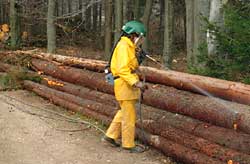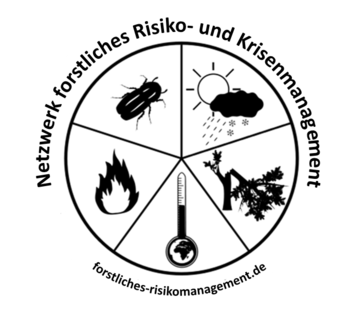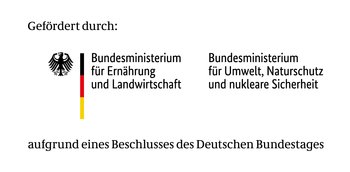Basic requirements
- Mechanical and biotechnological measures can no longer be applied efficiently for lack of capacities.
- No local restrictions forbidding insecticide use apply (distance to water bodies, protected areas, etc.)
| Bark borers | Wood borers | |
| Why? |
|
|
| What? |
|
|
| When? |
|
|
| Where? |
|
|
| How? |
|
|
| Who? |
|
|
| Tab. 1: Overview: Preconditions for the application of insecticides. |
Instructions for professional application of insecticides

Pic. 1: Professional application of insecticides. Photo H.-J. Schröter.
Laws and regulations on protective agents must be observed when considering insecticide application.
The forest owner has to decide whether or not to use insecticides for insect control. He is the one responsible for professional and proper handling of protective agents (Good Forestry Practice). The following principles should be kept in mind when using insecticides:
- According to the basic principles of Integrated Forest Protection, insecticides should only be used as last resort
- Protective agents should only be handled by competent workers with training certificate
- Always wear protective clothing
- Use only registered equipment
- Follow instructions for use. Approval is based on these instructions, e.g. minimum distance to water bodies, bee protection measures, etc.
- Observe all legal restrictions, e.g. protection area regulations
- Mind certification regulations in certified forests (e.g. PEFC, FSC)
What effects do these agents have on insects?
The active components affect the neural system of the insects. Stimulated nerves do not fall back into resting state (permanent alarm). Results for sensitive insects are initially uncontrolled movement, then death.
What other characteristics do the insecticides have?
Due to the low water solubility, the active component is very rain resistant. Thereby, long effective periods can be achieved even during spells of adverse weather conditions. Effects can be delayed by high temperatures (> 25 °C). Very high temperatures over 30 °C can delay effects up to two days. Optimum temperature range is 17 – 20 °C.
How do the insecticides decompose?
| Days after application | Sample | Remaining components in mg per kg dry wood | Reduction in % |
| 14 | Bark Sapwood Heartwood | 1210 030 02 | 100 |
| 84 | Bark Sapwood Heartwood | 710 020 01 | 42 |
| 168 | Bark Sapwood Heartwood | 42-560 010 01 | 54-66 |
| Tab. 1:Residues on spruce logs stored alongside the forest road after conventional application of Ripcord 40 (WULF, A. et al. 1993). |
How toxic are pyrethroids for endotherms?
- Low toxicity for endotherms;
- Pyrethroids do not cause cancer;
- No negative effects on reproduction;
- No teratogenic effects;
- No genotoxic effects.
Risk to human health can be characterised by the following parameters:
| Alpha-Cypermethrin | Cypermethrin | Cyhalothrin | |
| Acute Toxicity LD 50 (mg/kg) Mallard duck Chicken Rat | 64 > 5000 mg/kg | > 10.000mg/kg > 2.000mg/kg 200 - 800 mg/kg | > 3.950 mg/kg 79 mg/kg |
| Acute dermal Toxicity Rat | > 2000 mg/kg | > 1600 mg/kg | 632 mg/kg |
| Inhalation toxicity (4 hours) Rat | > 1,59 mg/m³ air | ||
| Irritations Skin Eyes | low-irritant low-irritant | low-irritant low-irritant | low-irritant low-irritant |
| Subchronic Toxicity (oral 90 days) NOEL (mg/kg body mass/day) Dog Rat | 92,3 | 0,5 | |
| Chronic Toxicity (oral 2 years) NOEL Rat | 5 | 5 | 50 |
| Depleted amount of compound per m³ | 0,9 g | 6 g | 1,2 g |
| Tab 2:Toxicity of pyrethroids. Acute Toxicity LD (= lethal dose) 50 oral: by ingestion LD 50 dermal: through skin LD 50: Lethal Dose 50: medium dose administered that kills half the test population within 14 days, in mg active compound per kg body mass LC 50: Lethal Concentration 50: medium concentration that kills half the test population, in mg active compound per m³ air Chronic Toxicity Dose without observable effects (No observable effect level (NOEL): mg compound per kg body mass per day ADI :acceptable daily intake |
What are the effects of pyrethroids on the biotic environment?
- Mammals: very low effects
- Birds: very low, no risk for wild birds (low compound concentration in alimentary animals)
- Fish: The insecticides are classified “acutely toxic” for fish and their alimentary animals. Therefore, minimum distances to water bodies must be adhered to!
- Earthworms: No toxic effects of the amounts that were applied.
- Microorganisms in the soil: No toxic effects of the amounts that were applied.
- Bees: There are usually no bees directly on stored logs, so applying the agents directly to the logs does not put bees at risk. But it is important to avoid drift to flowering plants.
- Useful animals (insects): The insecticides are classified “harmful” for relevant useful organisms. This mainly comprehends insects that are present on the logs during application or get caught in atomised spray. In this respect, predatory or parasitic insects will effectively not be strongly affected.
Environmental behaviour of the insecticides?
- In endotherms:
- The active compounds are decomposed inside the organism. No accumulation was found. The metabolites were all excreted. A study on pyrethroids by the German federal institute for consumer’s health protection and veterinary medicine (BgVV, Bundesinstitut für gesundheitlichen Verbraucherschutz und Veterinärmedizin, 1993) came to the conclusion that “…even though no evidence of pyrethroid poisoning on a big scale could be found in Germany, we warn against thoughtless use of pesticides. …If application is nevertheless necessary, they should be used with great care, especially when used near residential areas.” This is even more so when pyrethroids are used in closed rooms. Prof. W. Lingk (BgVV) told the FVA “…that there are no concerns from a human toxicological point of view against using Cypermethrin in forestry, if applied according to (German) regulations.”. The BgVV is, together with the Federal Environmental Agency (Umweltbundesamt), in charge of regulatory approval of pesticides.
- In soil, water air:
- Soil: Decomposition of the compounds seems to be rather unconnected to soil type, they are adsorbed by different soil particles. Ground water is not contaminated as the compounds are not washed out into deeper soil layers. Decomposition in the soil happens by hydrolysis (saponification) within 16 weeks (for Cypermethrin). Metabolites are harmless. Half-life in the soil: a few days to 13 weeks, depending on soil type.
- Water: Compounds are unstable in water. The higher the pH-value, the higher the decomposition rate. Decomposition is accelerated by light exposure and adsorption of organic substances. Microorganisms play an important role in decomposing the compounds as well.
- Air: A few hours are enough time for 50% of the compound that is potentially in the air after an application to break down.
- Soil: Decomposition of the compounds seems to be rather unconnected to soil type, they are adsorbed by different soil particles. Ground water is not contaminated as the compounds are not washed out into deeper soil layers. Decomposition in the soil happens by hydrolysis (saponification) within 16 weeks (for Cypermethrin). Metabolites are harmless. Half-life in the soil: a few days to 13 weeks, depending on soil type.
- Withdrawal period, maximum residue quantities
Precautionary measures when applying insecticides
- Protection of the handler
Follow instructions for use closely!
Avoid all unnecessary contact with the agent. When handling undiluted compounds and during application, wear the following protective gear:
Universal protective gloves, standard protective clothing, rubber boots, half mask (DIN 58646 HM) with combined filter A1-P2 (DIN EN 141).
Remember precautionary measures for operators of debarkers when handling treated timber during the effective period of the agent (e.g. working in an enclosed cabin).
On contact, the agents can cause a rash-like prickle or burning on the skin. Avoid further contact in any case! Call on a doctor if symptoms do not abate.
- General safety instructions
Keep agents out of the reach of children!
Store away from foodstuffs, beverages, and animal feed!
Do not eat, drink or smoke while handling!
Classification of insecticides:
Classification is relevant for packaging, storing, transport, and handling of undiluted and diluted agents.
| Xn = harmful | Xi = irritant |
Should the stacks be marked "toxic","Xn" or "Xi" for the protection of the general public?
Labelling of treated stacks is not necessary for the protection of general public health. Concentrations are too low, and the agents stick well to wood and bark. You might however want to consider labelling for general legal reasons of liability for premises.
What do I have to bear in mind when disposing of packaging?
Rinsed packaging materials can be disposed of via domestic waste. Packaging with residues of the agent must be treated as hazardous waste and disposed of according to national laws and regulations.
What are producing companies liable for?
- Manufacturers must ensure that their product is suited for the recommended use if the instructions for use are observed. They are not responsible for damage caused by improper storage or use.
Download
Sources
- Bundesamt für Verbraucherschutz und Lebensmittelsicherheit
- Braunschweig (BVL): Pflanzenschutzmittelverzeichnis Teil 4 Forst (54. Aufl. 2006, Saphir-Verlag, Ribbesbüttel).
- Bundesamt für Verbraucherschutz und Lebensmittelsicherheit (BVL): Verzeichnis zugelassener Pflanzenschutzmittel.
- Bundesministerium für Ernährung, Landwirtschaft und Verbraucherschutz (BMEVL): Grundsätze für die Durchführung der guten fachlichen Praxis im PflanzenschuEtz
- Cyanamid Agrar (1995): Der Wirkstoff Alpha-Cypermethrin FASTAC. Technische Produktinformatio.n
- IVA (Industrieverband Agrar e. V., 1991): Informationen zum Wirkstoff Cypermethrin
- PERKOW(1999): Wirksubstanzen der Pflanzenschutz- und Schädlingsbekämpfungsmittel. Paul Parey Verlag
- Wulf, A. et al. (1993): Zur Belastung von Fichtenholz und -rinde durch Ripcord 40 und Lindan nach praxisüblicher Borkenkäferbekämpfung. Nachrichtenbl. Dt. Pflanzenschutzd. 45, 172-17
Forest Crises Management Advisory Guide
Back to the main page of the Forestry Crisis Management Advisor Guide: Overview of the different topic collections
Back to the article overview in the: Storm Topic Collection – Coping with Storm Damaged Timber


